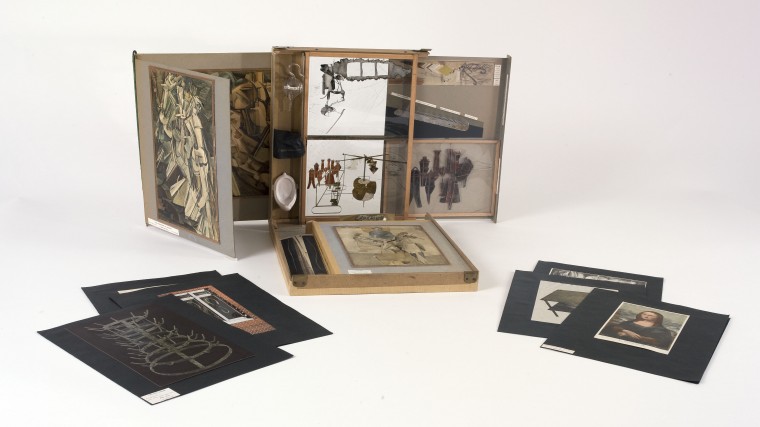It is a life’s work, a portable museum, a one-person retrospective the size of a small suitcase.
In “Boîte-en-valise (Box in a Valise),” Marcel Duchamp gathers photographs, scale models and hand-colored reproductions of his most iconic paintings, sculptures and ready-mades, complete with miniature frames and labels. The result is both a summary of Duchamp’s artistic aims and — with its clear reference to a salesman’s sample case — a sly, self-deprecating critique of the art object as rarified commodity.
Beginning in 1935, Duchamp created seven editions of his “Boîtes,” corresponding to the letters A through G. Now the Mildred Lane Kemper Art Museum at Washington University in St. Louis has acquired an early example, from the B series, as part of its permanent collection.
“Duchamp’s conception of the ready-made fundamentally changed accepted understandings of what constitutes an art object and altered the course of art history,” said Sabine Eckmann, the William T. Kemper Director and chief curator at the Mildred Lane Kemper Art Museum. “As a summary of Duchamp’s entire artistic oeuvre, the ‘Boîte’ is among the most significant works of art of the 20th century.”
Unfolding the box reveals a standing wooden frame displaying “The Bride Stripped Bare by her Bachelors, Even (The Large Glass)” (1915–23). Sliding pullouts contain “Nude Descending a Staircase (1912), and “Comb” (1916), among others, while miniature versions of “Fountain” (1917), “Traveler’s Folding Item” (1916) and “Air de Paris” (1919) hang in a column. Collected within the case’s lower portion are mounted prints of works such as “Bottle Rack” (1914), “Apolinère Enameled” (1916-17) and “L.H.O.O.Q.” (1919), Duchamp’s puckish take on the “Mona Lisa.”
Meredith Malone, associate curator at the Kemper Art Museum, said that though the museum includes strong collections of early and mid-20th-century European and American modernism, it previously owned just one work by Duchamp: the slim “Pocket Chess Set” (1944), which the artist had made for ease of travel during World War II.
“The ‘Boîte’ will provide an incredible teaching tool for Washington University and the larger St. Louis arts community,” Malone said. “It provides an unparalleled overview of Duchamp’s artistic practice, and powerfully impacts the Museum’s ability to tell a broader narrative about the history of modernism.”
In conjunction with the acquisition, Michael Taylor, chief curator and deputy director for art and education at the Virginia Museum of Fine Arts, will discuss Duchamp’s “Boîte-en-valise” at 6:30 p.m. Monday, Oct. 26, in Steinberg Auditorium. The talk, presented as part of the Sam Fox School of Design & Visual Arts’ fall Public Lecture Series, will examine the history and reception of the work, as well as its importance for artists working today.
For more information about the Kemper Art Museum, visit kemperartmuseum.wustl.edu or follow the museum on Facebook, Twitter and Instagram.
